Electronic Health Records at Calvary Healthcare: An Overview
VerifiedAdded on 2022/08/26
|14
|1221
|15
Report
AI Summary
This report examines the implementation and impact of Electronic Health Records (EHRs) within Calvary Healthcare's aged care facilities. It begins with an introduction to EHRs and their evolution, followed by an overview of Calvary Healthcare's operations, including its residential care facilities. The r...

INTRODUCTION TO EHR
NAME OF THE STUDENT
NAME OF THE
NAME OF THE STUDENT
NAME OF THE
Paraphrase This Document
Need a fresh take? Get an instant paraphrase of this document with our AI Paraphraser
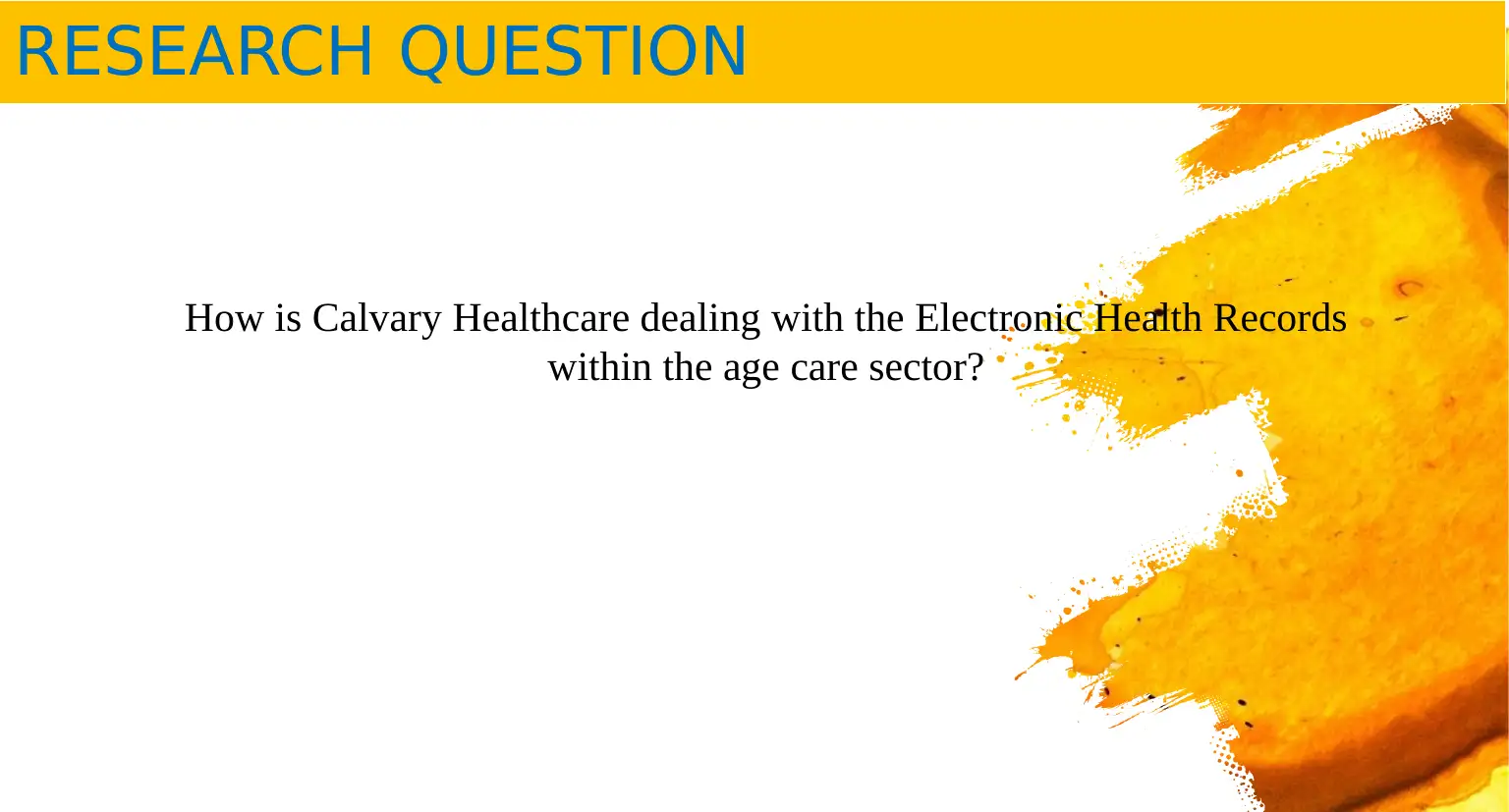
RESEARCH QUESTION
How is Calvary Healthcare dealing with the Electronic Health Records
within the age care sector?
How is Calvary Healthcare dealing with the Electronic Health Records
within the age care sector?
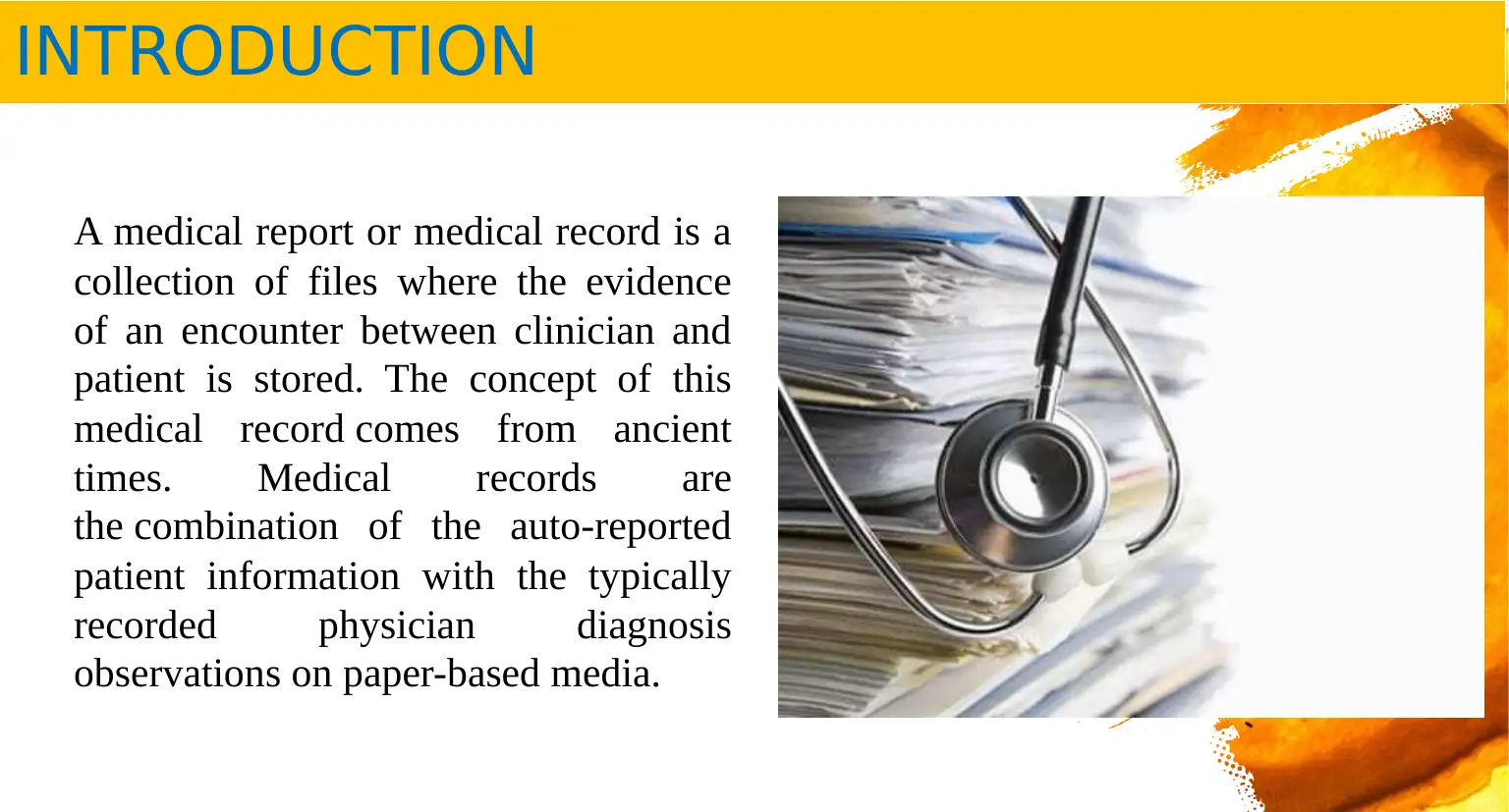
INTRODUCTION
A medical report or medical record is a
collection of files where the evidence
of an encounter between clinician and
patient is stored. The concept of this
medical record comes from ancient
times. Medical records are
the combination of the auto-reported
patient information with the typically
recorded physician diagnosis
observations on paper-based media.
A medical report or medical record is a
collection of files where the evidence
of an encounter between clinician and
patient is stored. The concept of this
medical record comes from ancient
times. Medical records are
the combination of the auto-reported
patient information with the typically
recorded physician diagnosis
observations on paper-based media.
⊘ This is a preview!⊘
Do you want full access?
Subscribe today to unlock all pages.

Trusted by 1+ million students worldwide
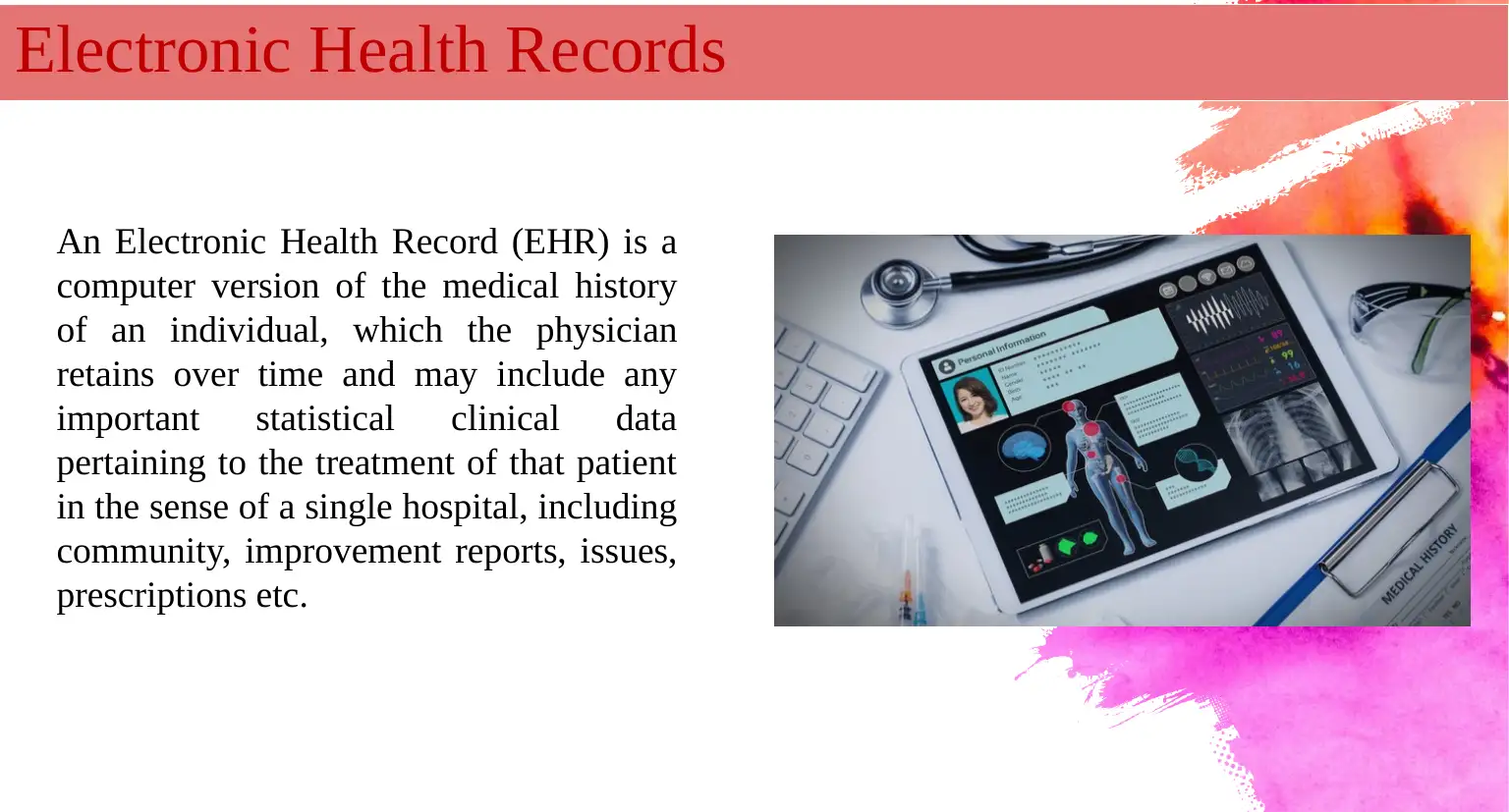
Electronic Health Records
An Electronic Health Record (EHR) is a
computer version of the medical history
of an individual, which the physician
retains over time and may include any
important statistical clinical data
pertaining to the treatment of that patient
in the sense of a single hospital, including
community, improvement reports, issues,
prescriptions etc.
An Electronic Health Record (EHR) is a
computer version of the medical history
of an individual, which the physician
retains over time and may include any
important statistical clinical data
pertaining to the treatment of that patient
in the sense of a single hospital, including
community, improvement reports, issues,
prescriptions etc.
Paraphrase This Document
Need a fresh take? Get an instant paraphrase of this document with our AI Paraphraser
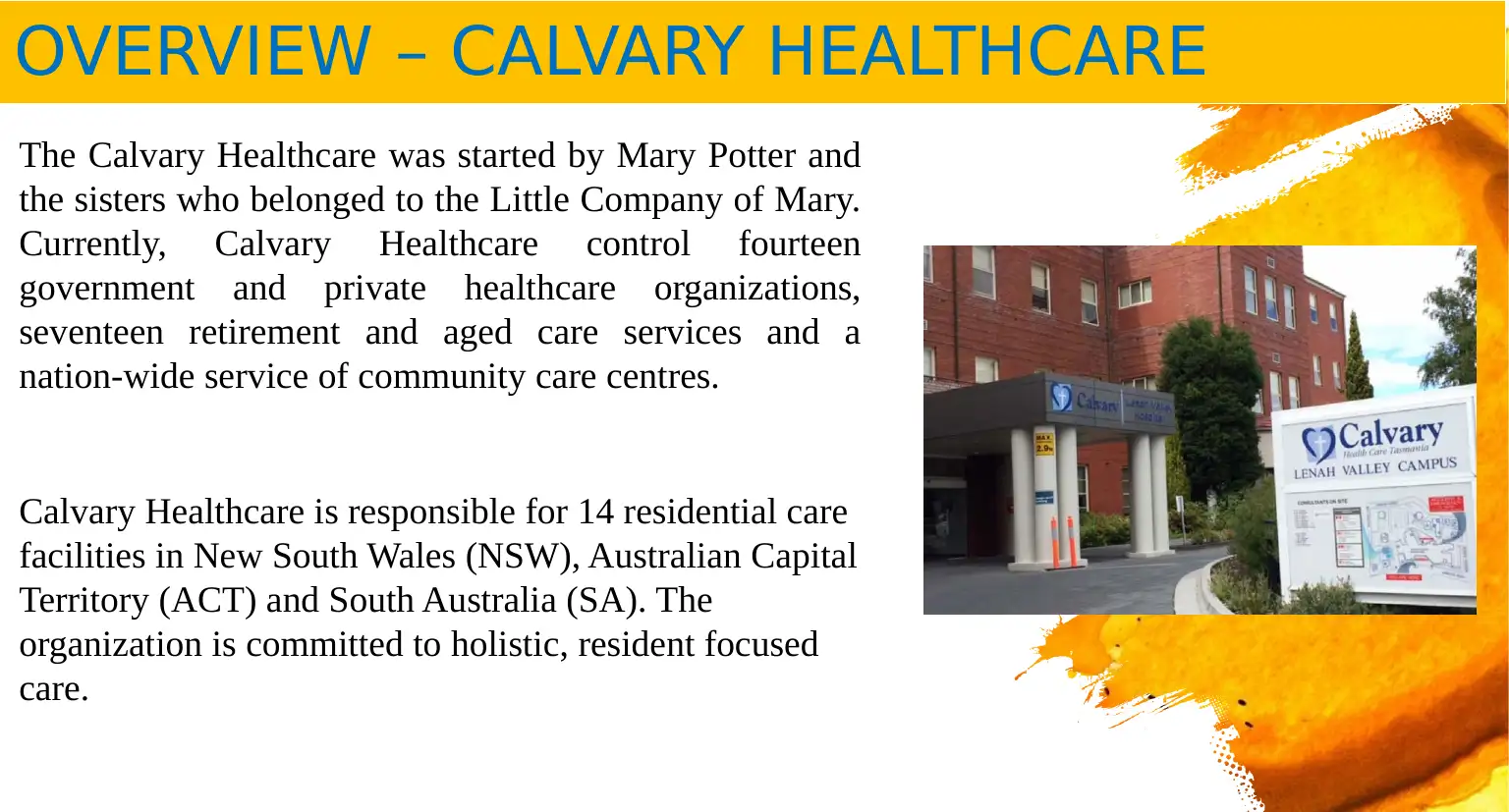
OVERVIEW – CALVARY HEALTHCARE
The Calvary Healthcare was started by Mary Potter and
the sisters who belonged to the Little Company of Mary.
Currently, Calvary Healthcare control fourteen
government and private healthcare organizations,
seventeen retirement and aged care services and a
nation-wide service of community care centres.
Calvary Healthcare is responsible for 14 residential care
facilities in New South Wales (NSW), Australian Capital
Territory (ACT) and South Australia (SA). The
organization is committed to holistic, resident focused
care.
The Calvary Healthcare was started by Mary Potter and
the sisters who belonged to the Little Company of Mary.
Currently, Calvary Healthcare control fourteen
government and private healthcare organizations,
seventeen retirement and aged care services and a
nation-wide service of community care centres.
Calvary Healthcare is responsible for 14 residential care
facilities in New South Wales (NSW), Australian Capital
Territory (ACT) and South Australia (SA). The
organization is committed to holistic, resident focused
care.
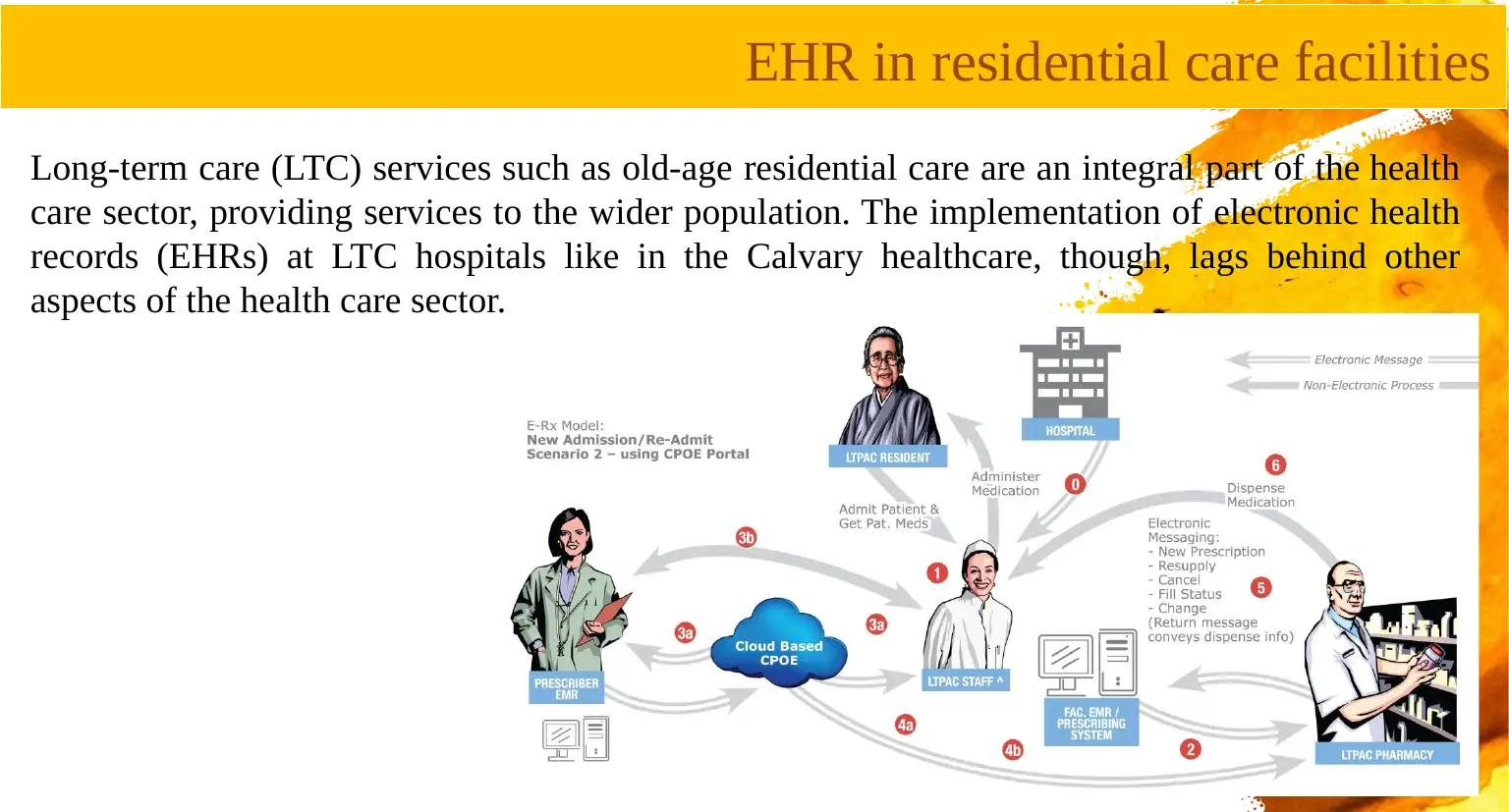
EHR in residential care facilities
Long-term care (LTC) services such as old-age residential care are an integral part of the health
care sector, providing services to the wider population. The implementation of electronic health
records (EHRs) at LTC hospitals like in the Calvary healthcare, though, lags behind other
aspects of the health care sector.
Long-term care (LTC) services such as old-age residential care are an integral part of the health
care sector, providing services to the wider population. The implementation of electronic health
records (EHRs) at LTC hospitals like in the Calvary healthcare, though, lags behind other
aspects of the health care sector.
⊘ This is a preview!⊘
Do you want full access?
Subscribe today to unlock all pages.

Trusted by 1+ million students worldwide
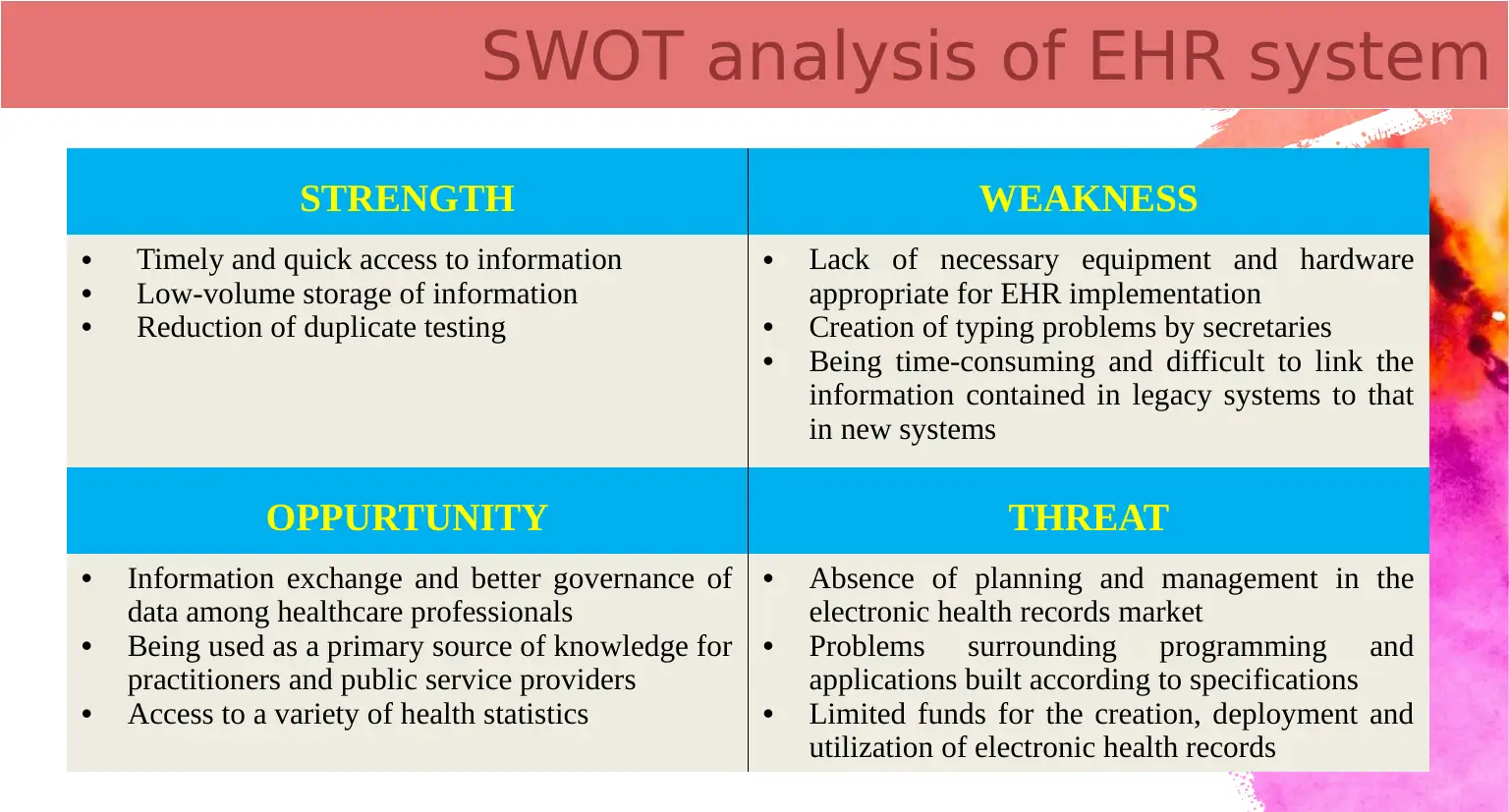
SWOT analysis of EHR system
STRENGTH WEAKNESS
• Timely and quick access to information
• Low-volume storage of information
• Reduction of duplicate testing
• Lack of necessary equipment and hardware
appropriate for EHR implementation
• Creation of typing problems by secretaries
• Being time-consuming and difficult to link the
information contained in legacy systems to that
in new systems
OPPURTUNITY THREAT
• Information exchange and better governance of
data among healthcare professionals
• Being used as a primary source of knowledge for
practitioners and public service providers
• Access to a variety of health statistics
• Absence of planning and management in the
electronic health records market
• Problems surrounding programming and
applications built according to specifications
• Limited funds for the creation, deployment and
utilization of electronic health records
STRENGTH WEAKNESS
• Timely and quick access to information
• Low-volume storage of information
• Reduction of duplicate testing
• Lack of necessary equipment and hardware
appropriate for EHR implementation
• Creation of typing problems by secretaries
• Being time-consuming and difficult to link the
information contained in legacy systems to that
in new systems
OPPURTUNITY THREAT
• Information exchange and better governance of
data among healthcare professionals
• Being used as a primary source of knowledge for
practitioners and public service providers
• Access to a variety of health statistics
• Absence of planning and management in the
electronic health records market
• Problems surrounding programming and
applications built according to specifications
• Limited funds for the creation, deployment and
utilization of electronic health records
Paraphrase This Document
Need a fresh take? Get an instant paraphrase of this document with our AI Paraphraser
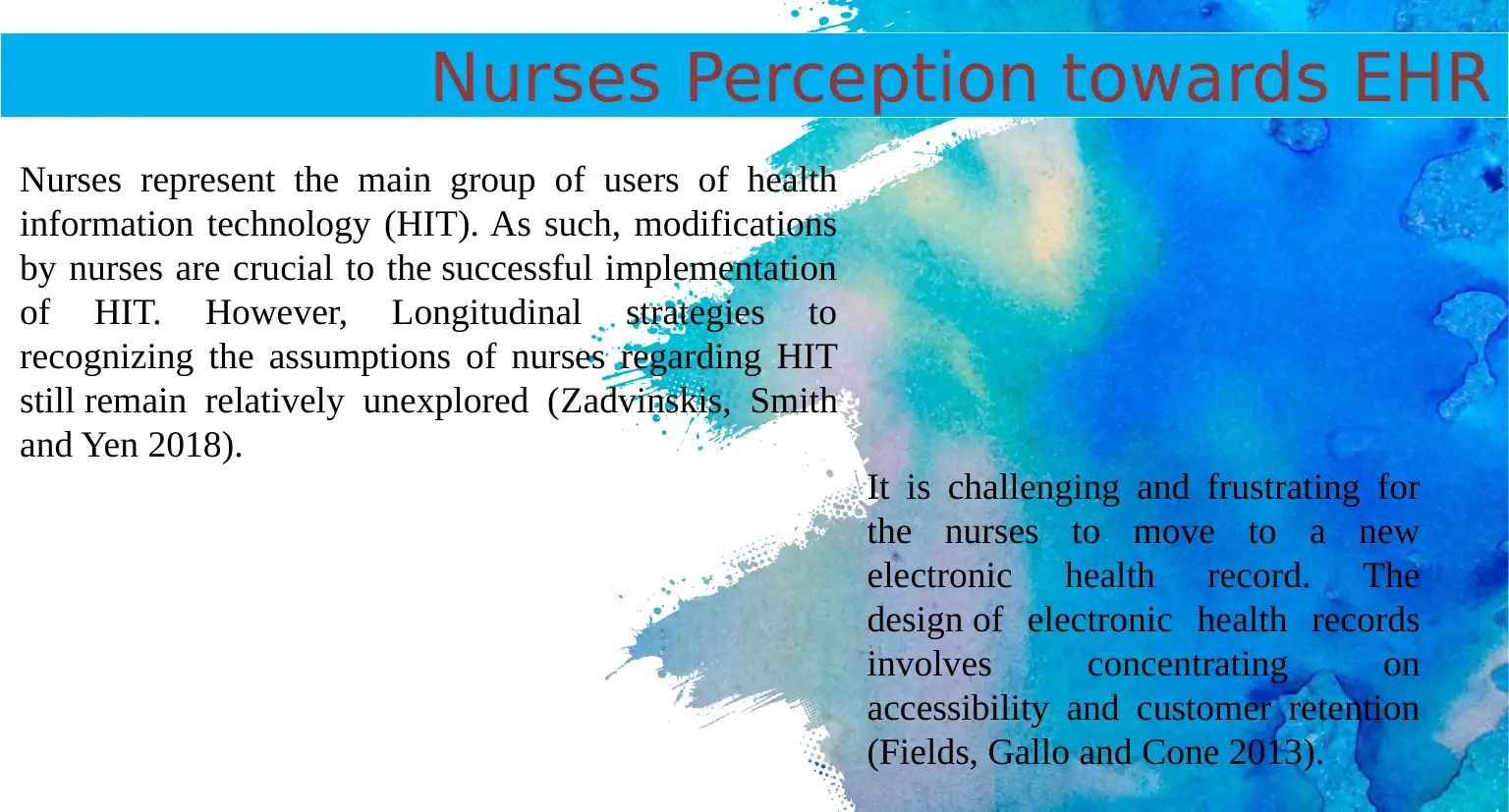
Nurses Perception towards EHR
Nurses represent the main group of users of health
information technology (HIT). As such, modifications
by nurses are crucial to the successful implementation
of HIT. However, Longitudinal strategies to
recognizing the assumptions of nurses regarding HIT
still remain relatively unexplored (Zadvinskis, Smith
and Yen 2018).
It is challenging and frustrating for
the nurses to move to a new
electronic health record. The
design of electronic health records
involves concentrating on
accessibility and customer retention
(Fields, Gallo and Cone 2013).
Nurses represent the main group of users of health
information technology (HIT). As such, modifications
by nurses are crucial to the successful implementation
of HIT. However, Longitudinal strategies to
recognizing the assumptions of nurses regarding HIT
still remain relatively unexplored (Zadvinskis, Smith
and Yen 2018).
It is challenging and frustrating for
the nurses to move to a new
electronic health record. The
design of electronic health records
involves concentrating on
accessibility and customer retention
(Fields, Gallo and Cone 2013).
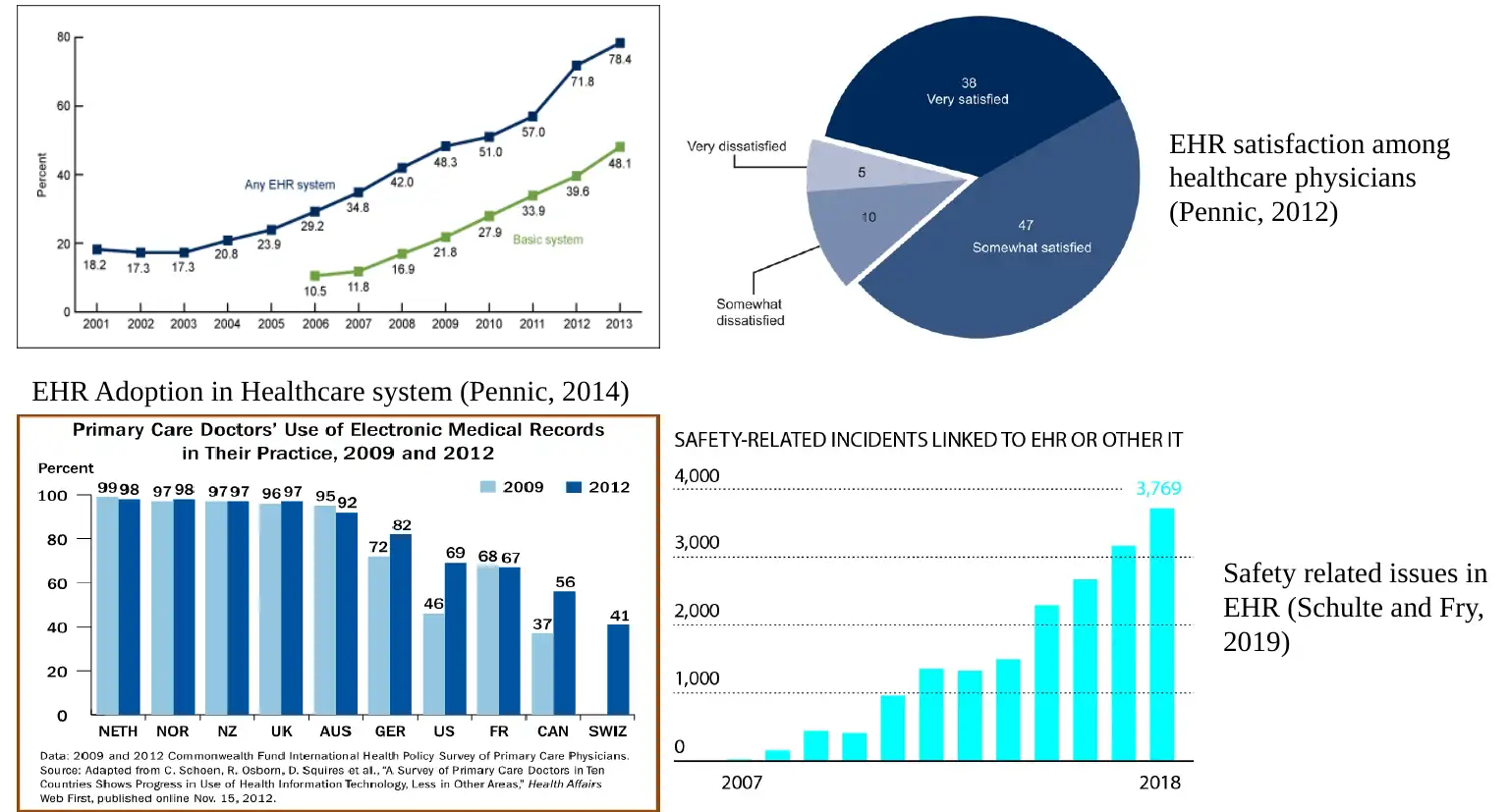
EHR Adoption in Healthcare system (Pennic, 2014)
EHR satisfaction among
healthcare physicians
(Pennic, 2012)
Safety related issues in
EHR (Schulte and Fry,
2019)
EHR satisfaction among
healthcare physicians
(Pennic, 2012)
Safety related issues in
EHR (Schulte and Fry,
2019)
⊘ This is a preview!⊘
Do you want full access?
Subscribe today to unlock all pages.

Trusted by 1+ million students worldwide

Ethical Issues and Responsibilities of EHR
There are four ethical issues
concerning the EHR (Ozair,
Jamshed, Sharma and Aggarwal
2015) -
• Privacy and Confidentiality
• Security Breaches
• System Implementation
• Data Inaccuracies
There are several responsibilities
or can be said function of an EHR
system (American Academy of
Family Physicians 2016) –
• Identifying and maintaining a
patient’s health record
• Management of patient
demographics
• Managing the list of problems
• Managing the list of medicines
• Demonstrate healthcare plans,
policies and procedures
There are four ethical issues
concerning the EHR (Ozair,
Jamshed, Sharma and Aggarwal
2015) -
• Privacy and Confidentiality
• Security Breaches
• System Implementation
• Data Inaccuracies
There are several responsibilities
or can be said function of an EHR
system (American Academy of
Family Physicians 2016) –
• Identifying and maintaining a
patient’s health record
• Management of patient
demographics
• Managing the list of problems
• Managing the list of medicines
• Demonstrate healthcare plans,
policies and procedures
Paraphrase This Document
Need a fresh take? Get an instant paraphrase of this document with our AI Paraphraser
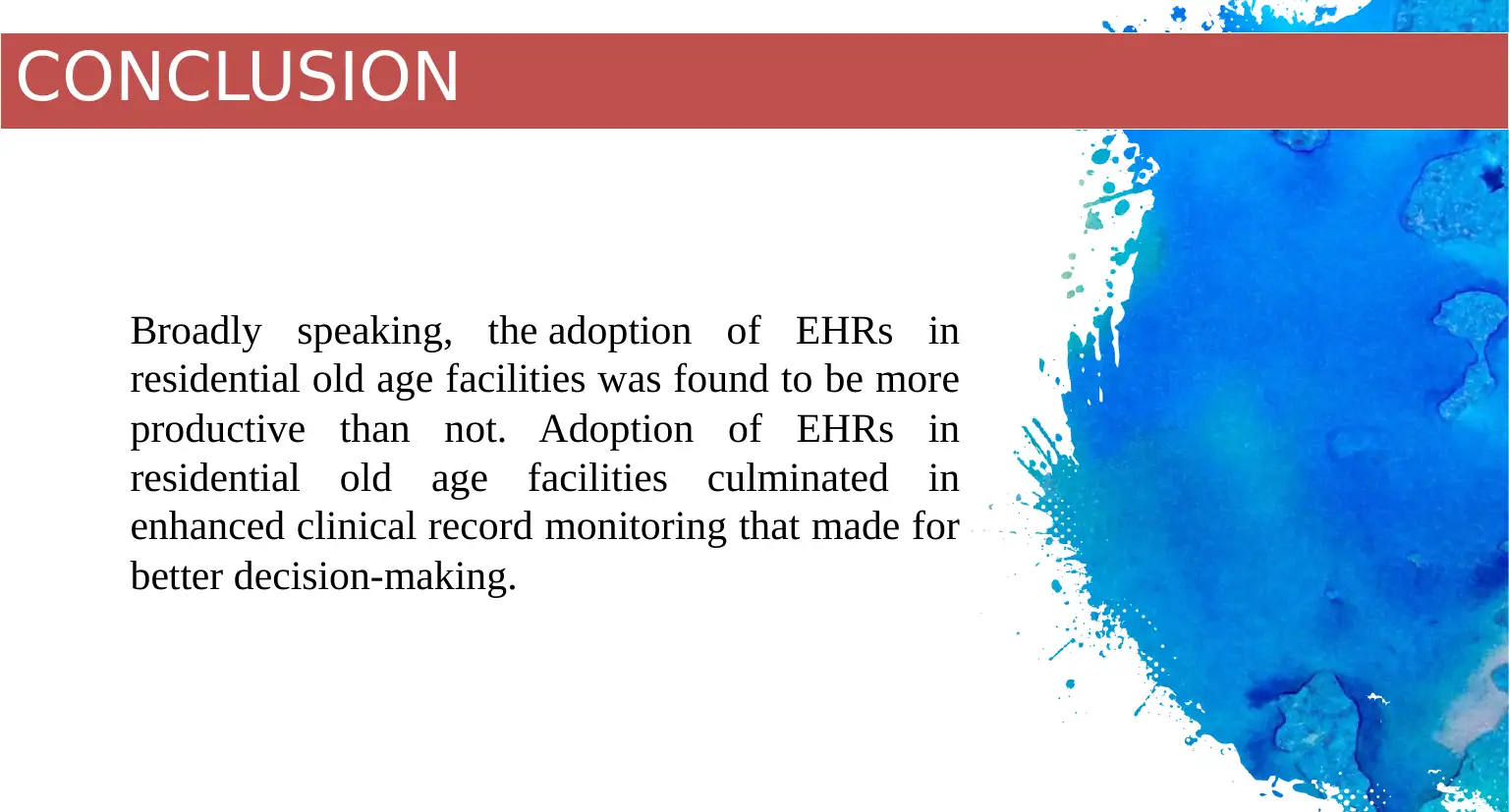
CONCLUSION
Broadly speaking, the adoption of EHRs in
residential old age facilities was found to be more
productive than not. Adoption of EHRs in
residential old age facilities culminated in
enhanced clinical record monitoring that made for
better decision-making.
Broadly speaking, the adoption of EHRs in
residential old age facilities was found to be more
productive than not. Adoption of EHRs in
residential old age facilities culminated in
enhanced clinical record monitoring that made for
better decision-making.
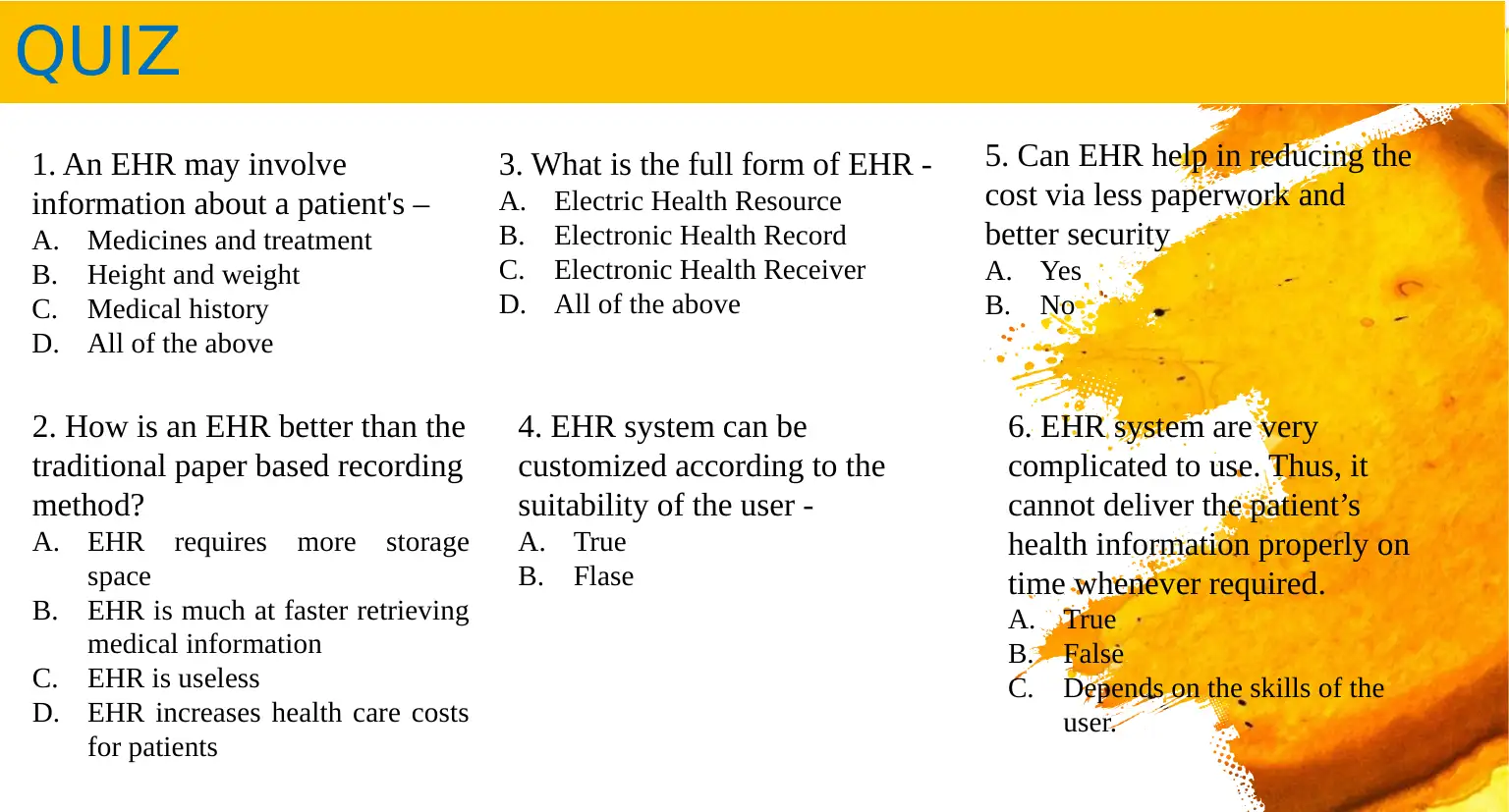
QUIZ
1. An EHR may involve
information about a patient's –
A. Medicines and treatment
B. Height and weight
C. Medical history
D. All of the above
2. How is an EHR better than the
traditional paper based recording
method?
A. EHR requires more storage
space
B. EHR is much at faster retrieving
medical information
C. EHR is useless
D. EHR increases health care costs
for patients
3. What is the full form of EHR -
A. Electric Health Resource
B. Electronic Health Record
C. Electronic Health Receiver
D. All of the above
4. EHR system can be
customized according to the
suitability of the user -
A. True
B. Flase
5. Can EHR help in reducing the
cost via less paperwork and
better security
A. Yes
B. No
6. EHR system are very
complicated to use. Thus, it
cannot deliver the patient’s
health information properly on
time whenever required.
A. True
B. False
C. Depends on the skills of the
user.
1. An EHR may involve
information about a patient's –
A. Medicines and treatment
B. Height and weight
C. Medical history
D. All of the above
2. How is an EHR better than the
traditional paper based recording
method?
A. EHR requires more storage
space
B. EHR is much at faster retrieving
medical information
C. EHR is useless
D. EHR increases health care costs
for patients
3. What is the full form of EHR -
A. Electric Health Resource
B. Electronic Health Record
C. Electronic Health Receiver
D. All of the above
4. EHR system can be
customized according to the
suitability of the user -
A. True
B. Flase
5. Can EHR help in reducing the
cost via less paperwork and
better security
A. Yes
B. No
6. EHR system are very
complicated to use. Thus, it
cannot deliver the patient’s
health information properly on
time whenever required.
A. True
B. False
C. Depends on the skills of the
user.
⊘ This is a preview!⊘
Do you want full access?
Subscribe today to unlock all pages.

Trusted by 1+ million students worldwide
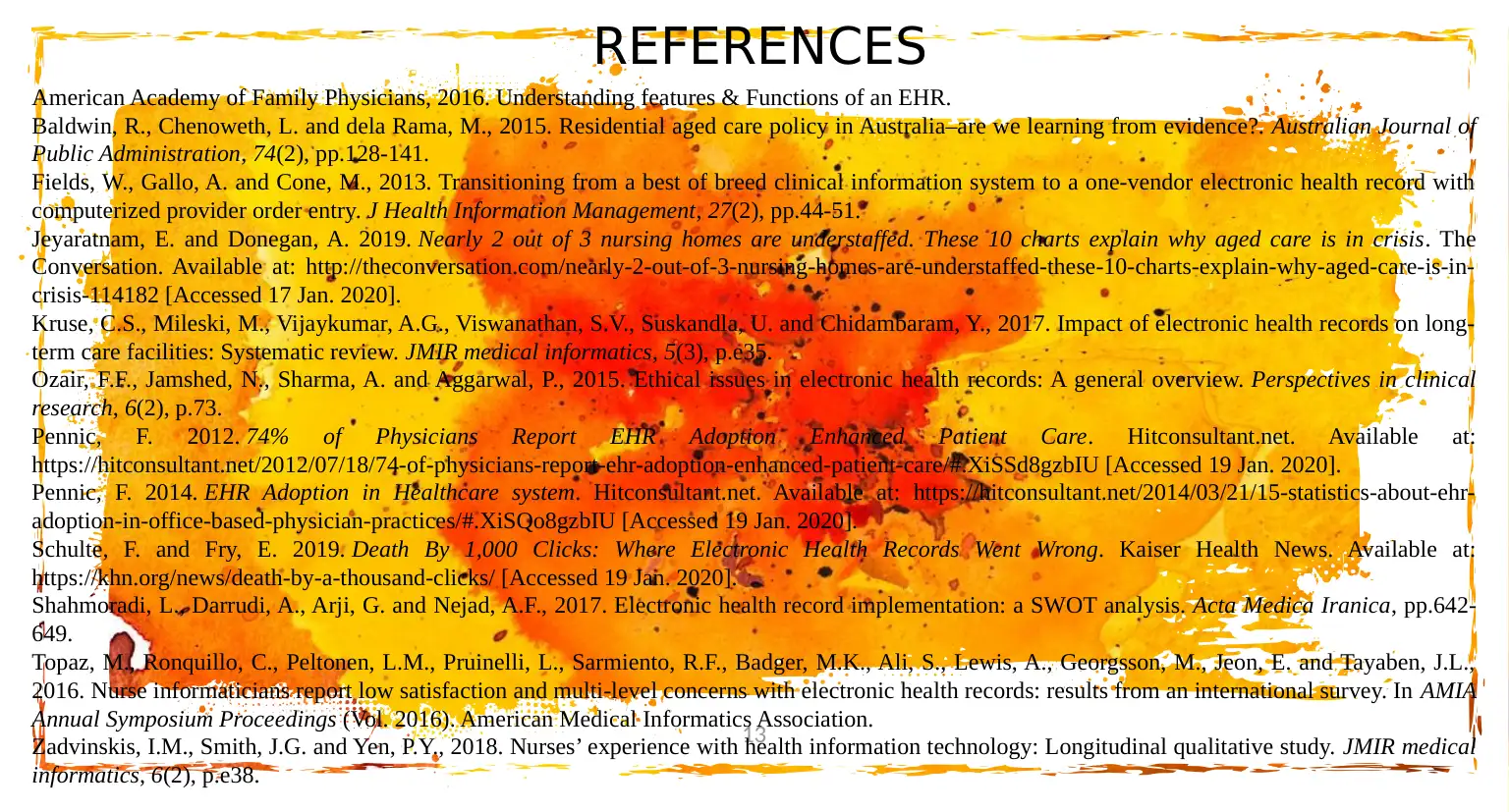
REFERENCES
13
American Academy of Family Physicians, 2016. Understanding features & Functions of an EHR.
Baldwin, R., Chenoweth, L. and dela Rama, M., 2015. Residential aged care policy in Australia–are we learning from evidence?. Australian Journal of
Public Administration, 74(2), pp.128-141.
Fields, W., Gallo, A. and Cone, M., 2013. Transitioning from a best of breed clinical information system to a one-vendor electronic health record with
computerized provider order entry. J Health Information Management, 27(2), pp.44-51.
Jeyaratnam, E. and Donegan, A. 2019. Nearly 2 out of 3 nursing homes are understaffed. These 10 charts explain why aged care is in crisis. The
Conversation. Available at: http://theconversation.com/nearly-2-out-of-3-nursing-homes-are-understaffed-these-10-charts-explain-why-aged-care-is-in-
crisis-114182 [Accessed 17 Jan. 2020].
Kruse, C.S., Mileski, M., Vijaykumar, A.G., Viswanathan, S.V., Suskandla, U. and Chidambaram, Y., 2017. Impact of electronic health records on long-
term care facilities: Systematic review. JMIR medical informatics, 5(3), p.e35.
Ozair, F.F., Jamshed, N., Sharma, A. and Aggarwal, P., 2015. Ethical issues in electronic health records: A general overview. Perspectives in clinical
research, 6(2), p.73.
Pennic, F. 2012. 74% of Physicians Report EHR Adoption Enhanced Patient Care. Hitconsultant.net. Available at:
https://hitconsultant.net/2012/07/18/74-of-physicians-report-ehr-adoption-enhanced-patient-care/#.XiSSd8gzbIU [Accessed 19 Jan. 2020].
Pennic, F. 2014. EHR Adoption in Healthcare system. Hitconsultant.net. Available at: https://hitconsultant.net/2014/03/21/15-statistics-about-ehr-
adoption-in-office-based-physician-practices/#.XiSQo8gzbIU [Accessed 19 Jan. 2020].
Schulte, F. and Fry, E. 2019. Death By 1,000 Clicks: Where Electronic Health Records Went Wrong. Kaiser Health News. Available at:
https://khn.org/news/death-by-a-thousand-clicks/ [Accessed 19 Jan. 2020].
Shahmoradi, L., Darrudi, A., Arji, G. and Nejad, A.F., 2017. Electronic health record implementation: a SWOT analysis. Acta Medica Iranica, pp.642-
649.
Topaz, M., Ronquillo, C., Peltonen, L.M., Pruinelli, L., Sarmiento, R.F., Badger, M.K., Ali, S., Lewis, A., Georgsson, M., Jeon, E. and Tayaben, J.L.,
2016. Nurse informaticians report low satisfaction and multi-level concerns with electronic health records: results from an international survey. In AMIA
Annual Symposium Proceedings (Vol. 2016). American Medical Informatics Association.
Zadvinskis, I.M., Smith, J.G. and Yen, P.Y., 2018. Nurses’ experience with health information technology: Longitudinal qualitative study. JMIR medical
informatics, 6(2), p.e38.
13
American Academy of Family Physicians, 2016. Understanding features & Functions of an EHR.
Baldwin, R., Chenoweth, L. and dela Rama, M., 2015. Residential aged care policy in Australia–are we learning from evidence?. Australian Journal of
Public Administration, 74(2), pp.128-141.
Fields, W., Gallo, A. and Cone, M., 2013. Transitioning from a best of breed clinical information system to a one-vendor electronic health record with
computerized provider order entry. J Health Information Management, 27(2), pp.44-51.
Jeyaratnam, E. and Donegan, A. 2019. Nearly 2 out of 3 nursing homes are understaffed. These 10 charts explain why aged care is in crisis. The
Conversation. Available at: http://theconversation.com/nearly-2-out-of-3-nursing-homes-are-understaffed-these-10-charts-explain-why-aged-care-is-in-
crisis-114182 [Accessed 17 Jan. 2020].
Kruse, C.S., Mileski, M., Vijaykumar, A.G., Viswanathan, S.V., Suskandla, U. and Chidambaram, Y., 2017. Impact of electronic health records on long-
term care facilities: Systematic review. JMIR medical informatics, 5(3), p.e35.
Ozair, F.F., Jamshed, N., Sharma, A. and Aggarwal, P., 2015. Ethical issues in electronic health records: A general overview. Perspectives in clinical
research, 6(2), p.73.
Pennic, F. 2012. 74% of Physicians Report EHR Adoption Enhanced Patient Care. Hitconsultant.net. Available at:
https://hitconsultant.net/2012/07/18/74-of-physicians-report-ehr-adoption-enhanced-patient-care/#.XiSSd8gzbIU [Accessed 19 Jan. 2020].
Pennic, F. 2014. EHR Adoption in Healthcare system. Hitconsultant.net. Available at: https://hitconsultant.net/2014/03/21/15-statistics-about-ehr-
adoption-in-office-based-physician-practices/#.XiSQo8gzbIU [Accessed 19 Jan. 2020].
Schulte, F. and Fry, E. 2019. Death By 1,000 Clicks: Where Electronic Health Records Went Wrong. Kaiser Health News. Available at:
https://khn.org/news/death-by-a-thousand-clicks/ [Accessed 19 Jan. 2020].
Shahmoradi, L., Darrudi, A., Arji, G. and Nejad, A.F., 2017. Electronic health record implementation: a SWOT analysis. Acta Medica Iranica, pp.642-
649.
Topaz, M., Ronquillo, C., Peltonen, L.M., Pruinelli, L., Sarmiento, R.F., Badger, M.K., Ali, S., Lewis, A., Georgsson, M., Jeon, E. and Tayaben, J.L.,
2016. Nurse informaticians report low satisfaction and multi-level concerns with electronic health records: results from an international survey. In AMIA
Annual Symposium Proceedings (Vol. 2016). American Medical Informatics Association.
Zadvinskis, I.M., Smith, J.G. and Yen, P.Y., 2018. Nurses’ experience with health information technology: Longitudinal qualitative study. JMIR medical
informatics, 6(2), p.e38.
Paraphrase This Document
Need a fresh take? Get an instant paraphrase of this document with our AI Paraphraser

14
THANK
Y
O
U
THANK
Y
O
U
1 out of 14
Related Documents
Your All-in-One AI-Powered Toolkit for Academic Success.
+13062052269
info@desklib.com
Available 24*7 on WhatsApp / Email
![[object Object]](/_next/static/media/star-bottom.7253800d.svg)
Unlock your academic potential
© 2024 | Zucol Services PVT LTD | All rights reserved.





